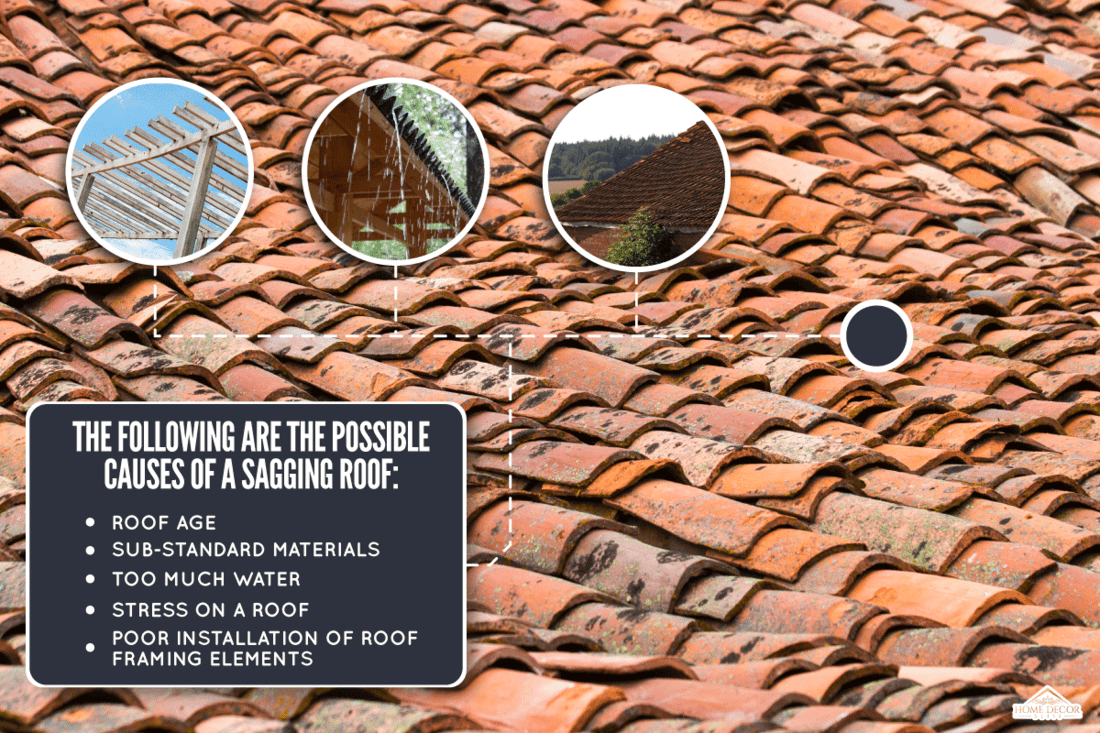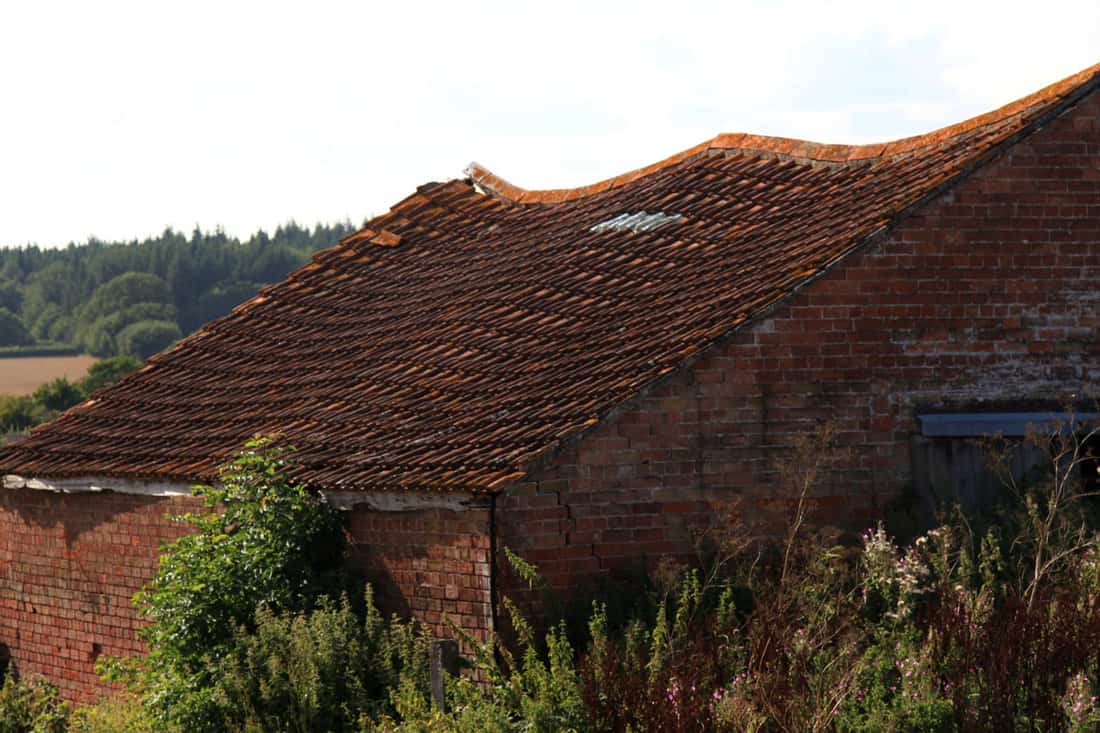Roofs are meant to protect, but they can also put your life in danger when they get damaged. If you're wondering why your roof is sagging, you're in luck! We've gathered helpful information that can assist you in identifying the potential cause of your roof's sagging as well as guides on how to fix the problem.
The following are the possible causes of a sagging roof:
- Roof age
- Sub-standard materials
- Too much water
- Stress on a roof
- Poor installation of roof framing elements
Don't worry if you have not yet checked your roof. Keep reading as we elaborate on the reasons why your roof may be sagging.

What Causes A Sagging Roof?
In order to fix your roof, you must first understand why it is sagging. The following are the main possible causes of your roof issue:
Roof Age
Even the best materials and installations eventually deteriorate. If you look at your roof and notice that it is sagging, find out how old your roof is. Depending on the materials used, the design of the roof, and the climate where it is located, roofs can last anywhere from 15 to 70 years.
If the roof is more than 30 years old, there may not be much more that can be done at this point, and it may be time to hire a specialist to replace the entire roof. It might be more cost-effective to replace it as opposed to having the sagging roof fixed.

We may include affiliate links and curated AI content to highlight top design styles.
Sub-Standard Materials

Is it possible for house contractors to use sub-standard materials to save a lot of money?
Using such material, especially for your roof, is an especially terrible idea. It will cause your roof to sag.
You're not only sacrificing everyone's safety, but the initial cost-saving measures will be offset by expensive repairs down the line, wasting money.
The use of sub-standard materials is a less common cause of a sagging roof in the U.S., though.
Too Much Water

Roofs get exposed to a lot of runoff over time, which is why understanding how rainfall drains off your roof is essential. Water tends to get into sensitive parts of your roof and seep in, causing water damage.
Over time, the humidity and stored moisture stimulate the growth of mold and mildew, further weakening and sagging your roof.
Stress On A Roof
During the snow season, your roof will be full of snow overnight or for the whole day. It puts stress on the roof and can weaken the structure and harm its structural integrity.
It is essential to regularly clean it off to prevent a significant accumulation of snow and ice.
Although most roofs are made to withstand significant snowfall, too much snow can weaken the internal structure. In an absolute worst-case scenario, this can cause the roof to collapse.
You should routinely use a plastic roof rake to clear snow off the roof after significant snowfalls. Use a plastic one to lessen the possibility of damaging your shingles.
Poor Installation Of Roof Framing Elements
The main purpose of the roof framing is to supply and maintain support for the roofing material, which serves as a barrier between the house's interior and the elements.
The framework for a roof is made up of rafters that are spaced apart and to which battens can be attached as well as the roofing material.
Any improper installation of roof frames, rafters, trusses, and other roof fundamentals that serve as the bones of our roofs may cause damage. Additionally, your roof will eventually sag even if you use standard materials.

How To Prevent Roof From Sagging
Rafters and joists or trusses are commonly used to support roofs. Rafters are two pieces of wood that run beneath and shape the roofing material. The joists fill the gap between the rafters' ends, providing structural support for the entire system.
Over time, rafters may degrade, split, or wear. Whatever the cause, there is always a solution to prevent these events from occurring. Here's one approach to it.
Install new rafters: In many cases, the solution entails installing new rafters right next to the weakened or broken ones. It is also possible to replace existing rafters without removing the roof, which requires great carpentry skills.
Watch this video for a visual guide on how to install new rafters to prevent your roof from sagging:
How Much Does It Cost To Repair A Roof?
Regular roof repairs are essential to keep a house protected from extremes and other forms of weather. Depending on the type of repair, the cost of a roof might vary from $150 to $400 for simple repairs to $7,000 for major maintenance.
Currently, the average cost of a roof repair in the US is approximately $950. Variables like roofing materials, labor costs, and the size of your roof all affect how much your repair will ultimately cost.
Types of Maintenance
- Minor: The cost of minor repairs ranges from $150 to $1,500. To complete this repair, no specialized skills or expertise are required. It only generally requires basic equipment. Although many people prefer to perform simple roof repairs themselves, if you have any questions about the repair or are concerned about safety, consult a professional.
- Major: These repairs might cost between $1,500 and $7,000 because they need specialized equipment, materials, and labor. You'll also need permits and inspections throughout the restoration procedure, depending on where you live. Major repairs are any that need significant electrical, plumbing, HVAC, or engineering work.
- Replacement: If your roof is more than 20 years old and has sustained substantial or persistent damage, you may need to replace it. A roof that is in good condition can last for more than 30 years. Contact a professional roofing firm if you are unsure whether your roof requires replacement or if repairs are sufficient. Representatives will frequently conduct a free initial examination of your roof. A complete roof replacement can cost far more than $8,000.
If your roof needs to undergo repair, check out these other posts for more insight:
11 Roof Shingles Color Ideas And Options
10 Best Colors For Metal Roofing
Asphalt Shingles or Metal Roofs?
There are so many varieties of roofing materials that are readily available around. Try to consider these two kinds:

Asphalt Shingles
This most popular type of residential roofing material in the United States is well-liked for its affordability and simplicity of installation. Asphalt shingles can be reinforced with cellulose or fiberglass without changing their appearance.
Advantages Of Using Asphalt Shingles
- Affordable: The price of installing a new roof is a concern for many homeowners. You can immediately reduce project costs by selecting a cost-effective roofing material. The least expensive option for many roofing projects is often asphalt shingles.
- Easy to Install: Asphalt shingles are lighter than heavy tile or big chunks of metal roofing and can typically be installed quickly and easily by someone with roofing experience. This will help you finish your project fairly quickly and save money on the labor necessary to install a roof.
Metal Roofs
Over the past 10 years, metal roofing has more than quadrupled its market share, making it one of the home improvement sectors with the fastest growth. The advantages of today's metal roofs enable homeowners to upgrade their homes with long-lasting materials.
Advantages Of Using Metal Roofs
- Durability: When properly installed, some metal roofs can withstand wind gusts of up to 140 mph, won't corrode or crack, and may even be impact-resistant (depending on which product you choose). Furthermore, metal roofs do not require the regular, costly maintenance that other roofing materials do. They should be inspected on a regular basis to ensure that no repairs are required.
- Lifespan: Conventional asphalt roofing materials have a lifespan of 12 to 20 years. Depending on the metal, metal roofs have a lifespan of 40 to 70 years.
- Energy Efficient: A metal roof will reduce cooling costs by 10 to 25 percent because it will reflect the sun's UV and infrared light rays, which cause radiant heat on the roof's surface.
Final Thoughts

The roof protects you and your loved ones from a variety of threats. It keeps out rain, wind, hail, and snow and also serves as insulation, keeping your home warm in the winter and cool in the summer, and absorbing the majority of sunlight.
As we have discussed the five causes of a sagging roof, it is critical to check your roof and invest in proper maintenance so that you can prevent costly repairs in the future.



